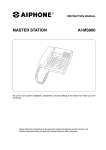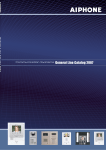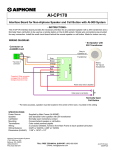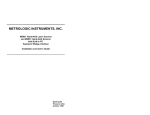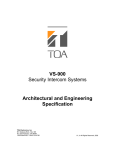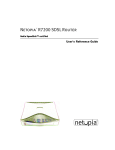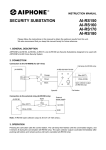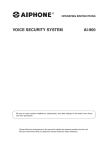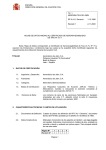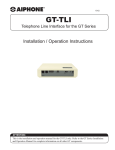Download Aiphone AI-900 Specifications
Transcript
TABLE OF CONTENTS 1. SAFETY PRECAUTIONS ..................................................................................... 4 2. FCC REQUIREMENTS ......................................................................................... 6 3. INDUSTRIAL CANADA REQUIREMENTS .................................................... 7 4. GENERAL DESCRIPTION .................................................................................. 8 5. FEATURES ............................................................................................................... 8 6. INSTALLATION PRECAUTIONS ....................................................................... 8 7. SYSTEM CONFIGURATION AND EQUIPMENT FUNCTIONS 7.1. System Configuration ............................................................................................. 9 7.2. Equipment Functions ............................................................................................ 10 8. AI-900MF MAIN FRAME NOMENCLATURE AND FUNCTIONS ........... 11 9. INSTALLATION AND CONNECTION PROCEDURES .............................. 12 10. EQUIPMENT INSTALLATION 10.1. AI-900MF Main Frame 10.1.1. Rack mounting ........................................................................................ 13 10.1.2. Wall mounting ......................................................................................... 14 10.2. AI-PU200 Power Transformer unit 10.2.1. Rack mounting ........................................................................................ 15 10.2.2. Wall mounting ......................................................................................... 16 10.3. AI-RS150, AI-RS160, AI-RS170 and AI-RS180 Substations .............................. 17 10.4. Master Station 10.4.1. Desk-top mounting .................................................................................. 18 10.4.2. Wall mounting ......................................................................................... 18 11. AI-900MF CARD INSTALLATION 11.1. Backup Battery Installation ................................................................................. 19 11.2. Card Installation .................................................................................................. 20 2 12. WIRING 12.1. Wiring from the Station or Outside Line .............................................................. 21 12.2. Supplied Connector Connection ......................................................................... 22 12.3. AI-900MS Master Station Interface Card Connection 12.3.1. Master Station and AI-900MS connection .............................................. 23 12.3.2. External recording device and AI-900MS connection ............................ 25 12.4. AI-MS900 Master Station Connection and Adjustment 12.4.1. External speaker connection .................................................................. 26 12.4.2. Speaker volume and microphone sensitivity adjustment ....................... 26 12.5. AI-900AL Telephone Interface Card Connection 12.5.1. Telephone and AI-900AL connection ..................................................... 27 12.5.2. External recording device and AI-900AL connection ............................. 29 12.6. AI-900RS Substation Interface Card Connection 12.6.1. Substation and AI-900RS connection .................................................... 30 12.6.2. External amplifier and AI-900RS connection .......................................... 31 12.7. AI-900CO Outside Line Interface Card Connection 12.7.1. Outside line and AI-900CO connection .................................................. 32 12.7.2. External recording device and AI-900CO connection ............................ 33 12.8. AI-900AF Audio Function Card Connection 12.8.1. Amplifier and AI-900AF connection ........................................................ 34 12.8.2. External sound source and AI-900AF connection .................................. 35 12.9. AI-900TI Tie-Line Interface Card Exchange Interconnection .............................. 36 12.10. AI-900MF Main Frame and AI-PU200 Power Transformer Connection ............ 39 13. MAIN FRAME AND PC CONNECTION 13.1. Programming PC Connection 13.1.1. Direct connection by means of RS-232C ............................................... 40 13.1.2. Connection via modem ........................................................................... 41 13.2. Operation Log PC Connection 13.2.1. Direct connection by means of RS-232C ............................................... 42 13.2.2. Connection via modem ........................................................................... 43 13.3. System Programming ......................................................................................... 43 14. SPEECH AND FUNCTION TESTS 14.1. Speech Test ........................................................................................................ 44 14.2. Function Test ...................................................................................................... 44 15. SPECIFICATIONS ................................................................................................. 45 Accessories .................................................................................................................. 45 3 2. FCC REQUIREMENTS (1) The AI-900 complies with FCC Rules, Part 68. On this equipment is a label which contains, among other information, the FCC Part 68 registration number. (2) The ringer equivalence number (REN) is used to determine the quality of devices which may be connected to the telephone line. Excessive RENs on the telephone line may result in the devices not ringing in response to an incoming call. In most, but not all areas, the sum of RENs should not exceed five (5.0). To be certain of the number of devices that may be connected to a line, as determined by the total RENs, contact the local telephone company. Note: RENs are associated with loop-start and ground-start ports. It is not used for E&M and digital ports. The REN assigned to the AI-900 is 0.4. If requested, this information must be given to the telephone company. (3) In the event of equipment malfunction, all repairs should be performed by AIPHONE CORPORATION or an authorized agent. It is the responsibility of users requiring service to report the need for service to AIPHONE CORPORATION or to one of our authorized agents. Service can be facilitated through our office at: AIPHONE CORPORATION 1700-130th Ave., N.E. Bellevue, Washington 98009 Phone (425) 455-0510 The telephone company can ask you to disconnect the equipment from the network until the problem is corrected or until you are sure that the equipment is not malfunctioning. (4) If the AI-900 disrupts the telephone network, the telephone company can discontinue your service temporarily. If possible, the telephone company will notify you in advance. If advance notice is not practical, they will notify you as soon as possible. You are also informed of your right to file a complaint with the FCC. (5) The telephone company can make changes in its facilities, equipment, operations, or procedures that can affect the operation of your equipment. If they do, you should be notified in advance so you have an opportunity to maintain uninterrupted telephone service. (6) While the AI-900 is fully compliant with FCC rules and regulations, it is recommended that an alternating current (ac) surge arrestor of the form and capability suitable for the model purchased be installed in the ac outlet to which the AIPHONE CORPORATION products are connected. Consult with your distributor as to the surge protector requirements for your equipment. (7) The FCC rules require that the following Affidavit be completed by the installer and forwarded to the local exchange carrier, whenever digital terminal equipment without encoded analog content and billing protection is used to transmit digital signals containing encoded analog content, which are intended for eventual conversion into Voiceband analog signals and retransmitted on the network. (8) The AI-900 has been tested and comply with the limits for a class A digital device, pursuant to Part 15 of the FCC Rules. These limits are designed to provide reasonable protection against harmful interference when the equipment is operated in a commercial environment. This equipment generates, uses, and can radiate radio frequency energy and, if not installed and used in accordance with the instruction manual, can cause harmful interference to radio communications. Operation of this equipment in a residential area is likely to cause harmful interference, in which case the user will be required to correct the interference in the user's expense. CHANGES OR MODIFICATIONS NOT EXPRESSLY APPROVED BY AIPHONE CORPORATION COULD VOID THE USER'S AUTHORITY TO OPERATE THE EQUIPMENT. 6 3. INDUSTRY CANADA REQUIREMENTS (1) ''NOTICE: This equipment meets the applicable Industry Canada Terminal Equipment Technical Specifications. This is confirmed by the registration number. The abbreviation, IC, before the registration number signifies that registration was performed based on a Declaration of Conformity indicating that Industry Canada technical specifications were met. It does not imply that Industry Canada approved the equipment." (2) ''NOTICE: The Ringer Equivalence Number (REN) for this terminal equipment is 0.4. The REN assigned to each terminal equipment provides an indication of the maximum number of terminals allowed to be connected to a telephone interface. The termination on an interface may consist of any combination of devices subject only to the requirement that the sum of the Ringer Equivalence Numbers of all the devices does not exceed five.'' (3) "The abbreviation, IC, before the registration number signifies that registration was performed based on a Declaration of Conformity indicating that Industry Canada technical specifications were met. It does not imply that Industry Canada approved the equipment. (4) This Class A digital apparatus complies with Canadian ICES-003. Cet appareil numérique de la classe A est conforme à la norme NMB-003 du Canada. 7 4. GENERAL DESCRIPTION The AI-900 Security System is a voice communication system that permits calls to be quickly and easily made - even in emergency situations - with the touch of single button. The system can record conversations, and features external equipment sync output and operation log output. These features combine to make the AI-900 an ideal system for voice security applications. 5. FEATURES • Modular construction facilitates installation, maintenance, and system expansion. • Rack- or wall-mountable exchange. • Up to 4 master stations (or commercial telephone sets) and 64 substations can be connected per exchange. • Up to 2 outside telephone (C/O) lines can be connected per exchange. • Station paging (by means of the substation speaker) and external paging functions. • External sound source distribution capability. • Up to 19 paging zones can be established. • Emergency Paging function. • By connecting an external recording device, the conversations at the master station (or telephone set) and at the outside line telephone can be recorded. • Exchange operating log can be transmitted to a PC. • Tie-line possible for up to 16 exchanges. • 24 V DC input for connection of backup power supply. • Manual/Automatic Call Forwarding, Conference, Scan Monitor functions. 6. INSTALLATION PRECAUTIONS • To prevent the unit's failure, be sure to switch off its power when inserting or removing the card. • When mounting each card, fully insert it into the Main Frame. After all cards are mounted, secure them with the card fixing bracket. • When the unit gets dirty with dust or oil, wipe down with a soft, dry cloth. Never use a chemically-treated cleaning cloth or volatile liquids, such as benzine and thinner, because the unit's plastic parts may be deformed or its finish discolored. • All units except the AI-RS170 and AI-RS180 Substations are designed exclusively for indoor use. Do not install them outdoors. • The whole system will not operate without power supply. • In areas where broadcasting stations are close by, the system operation may be affected by radio frequency interference. • Keep DC wiring at least 30 cm away from AC wiring. Otherwise, the system may malfunction. 8 7. SYSTEM CONFIGURATION AND EQUIPMENT FUNCTIONS 7.1. System Configuration AI-900 Exchange (1) Rack Mount Panel AI-PN100B Power Transformer Uint AI-PU200 Main Frame AI-900MF/ Main Frame Mounting Bracket AI-YC303 Master Station Interface Card AI-900MS (1) Master station AI-MS900 (2 units) Telephone Interface Card AI-900AL (2) Telephone (2 units) Power Transformer Uint AI-PU200 Recording voice output (for each station) Recording control output (for each station) Recording voice output (for each telephone) Recording control output (for each telephone) Substation Interface Card AI-900RS (1) Substation AI-RS150, AI-RS160, AI-RS170 or AI-RS180 (16 units) Paging output (to an amplifier) Paging input (from an amplifier) Substation Interface Card AI-900RS (4) Outside Line Interface Card AI-900CO Outside line (2 lines) Audio Function Card AI-900AF External paging voice output External paging control output (16 channels) Voice input for external source distribution Control input for external source distribution (4 channels) Tie-line Interface Card AI-900TI Recording voice output (for each line) Recording control output (for each line) Input and output for exchange interconnection (4 voice lines, 1 data line) AI-900 Exchange (2) AI-900 Exchange (16) 9 7.2. Equipment Functions • AI-900MF Main Frame The AI-900MF accommodates the following cards: Up to 2 AI-900MS or AI-900AL Cards (both cards may be mixed), up to 4 AI-900RS Cards, 1 AI-900CO Card, 1 AI-900AF Card, and 1 AI-900TI Card. The Main Frame has 2 RS-232C ports; one for programming and the other for operation log output. • AI-900MS Master Station Interface Card The AI-900MS is used for master station connection. Up to 2 master stations can be connected per card, and an external recording device can be connected to each line. • AI-900AL Telephone Interface Card The AI-900AL is used for connecting telephone sets (in compliance with the FCC Regulation Part 68). Up to 2 telephones can be connected per card, and an external recording device can be connected to each line. • AI-900RS Substation Interface Card The AI-900RS is used for substation connection. Up to 16 substations can be connected per card. The Substation Interface Card has 2 speech links, one of which also functions as a paging link with the paging input/output connected to an external amplifier. • AI-900CO Outside Line Interface Card The AI-900CO is used for outside line connection. Up to 2 outside lines can be connected per card, and an external recording device can be connected to each line. • AI-900AF Audio Function Card The AI-900AF enables Conference, External Amplifier Paging, and External Source Distribution functions. The Audio Function Card has 1 conference link (maximum 4 stations), 1 voice output and 16 control outputs for external amplifier paging, and 1 voice input and 4 control inputs for external source distribution. • AI-900TI Tie-Line Interface Card The AI-900TI is used to interconnect multiple exchanges. The Tie-Line Interface Card can connect up to 4 links made up by 1 pair of data lines and 2 pairs of voice lines. • AI-PU200 Power Transformer Unit The wall-mountable AI-PU200 has 2 20V/2.5A AC outputs. One AI-PU200 unit is required when up to 2 AI-900RS Cards are installed, and 2 AI-PU200 units are required when 3 or more AI-900RS Cards are installed. • AI-YC303 Main Frame Wall Mounting Bracket The AI-YC303 is used when mounting the main frame on the wall. • AI-PN100B Rack Mount Panel The AI-PN100B provides side-by-side rack mounting capability for up to 2 AI-PU200 transformer units. • AI-MS900 Master Station The AI-MS900 can make calls to or receive calls from the substation. It utilizes 2 pairs of twisted cables. • AI-RS150 Substation (Indoor Type) The AI-RS150 can call and converse with the registered master stations. It utilizes a single-pair shielded cable. • AI-RS160 Substation (Indoor Vandal-Resistant Type) The AI-RS160 can call and converse with the registered master stations. It utilizes a single-pair shielded cable. • AI-RS170 Substation (Outdoor Vandal-Resistant Type) The AI-RS170 can call and make converse with the registered master stations. It utilizes a single-pair shielded cable. • AI-RS180 Substation (for Emergency Use) The AI-RS180 can call and converse with the registered master stations. It has a indicator lamp and a control output channel, and utilizes a single-pair shielded cable. 10 8. AI-900MF MAIN FRAME NOMENCLATURE AND FUNCTIONS 1 2 3 12 10 4 11 5 1. AC Input Connectors Connect to the AC output terminal of the AI-PU200 power transformer unit. (See p. 39.) 2. 24 V DC Input Connector Connects to a battery (24 V DC). (See p. 39.) 3. Power Switch Power is switched on (I) and off (O) with each depression of this switch. 4. Backup Battery Socket Insert the CR2032 data backup battery into this socket. (See p. 19.) 5. AI-900MS/AI-900AL Installation Slot [MS/AL 1-2] A maximum of 2 AI-900MS or AI-900AL cards can be installed. (See p. 24 and 29.) 6 7 8 9 7.AI-900CO Installation Slot [CO] One AI-900CO card can be installed. (See p. 32.) 8. AI-900AF Installation Slot [AF] One AI-900AF card can be installed. (See p. 34.) 9. AI-900TI Installation Slot [TI] One AI-900TI card can be installed. (See p. 36.) 10. Programming PC Connector [RS-232C] Connects to the programming PC either directly or via modem. (See p. 40.) 11. Operation Log PC Connector [RS-232C] Connects to the operation log PC either directly or via modem. (See p. 42.) 12. Power Indicator Lights when the power switch is set to ON. 6. AI-900RS Installation Slot [RS 1-4] A maximum of 4 AI-900RS cards can be installed. (See p. 30.) 11 9. INSTALLATION AND CONNECTION PROCEDURES (1) System Design Exchange/Station Configuration, Wiring Schedule and Station Numbering Schedule (2) Equipment Installation Installing the AI-900MF Main Frame in an Equipment Rack or on a Wall (See p. 13.) Installing the AI-PU200 Power Transformer in an Equipment Rack or on a Wall (See p. 15.) Installing the Substation (See p. 17.) Installing the Master Station (See p. 18.) (3) Installing a Card in the AI-900MF Main Frame Installing the Data Backup Battery (See p. 19.) Installing and Connecting Each Card (See p. 20.) (4) Connecting the Station/Outside Line to Each Exchange Card • AI-MS900 Master Station vs. AI-900MS Card • External Recording Device vs. AI-900MS Card (See p. 23.) (See p. 25.) • Telephone vs. AI-900AL Card • External Recording Device vs. AI-900AL Card (See p. 27.) (See p. 29.) • Substation vs. AI-900RS Card • External Amplifier vs. AI-900RS Card (See p. 30.) (See p. 31.) • Outside Line vs. AI-900CO Card • External Recording Device vs. AI-900CO Card (See p. 32.) (See p. 33.) • External Amplifier vs. AI-900AF Card • External Recording Device vs. AI-900AF Card (See p. 34.) (See p. 35.) AI-900MF Main Frame vs. AI-PU200 Power Transformer (See p. 39.) (5) Tie-Line Connection (between Exchanges) AI-900TI vs. AI-900TI (See p. 36.) (6) Connecting the AI-900MF Main Frame to a PC Connection to a Programming PC (See p. 40.) Connection to an Operation Log PC (See p. 42.) Power-ON (7) Adjusting the Station and Exchange System Programming (See the "AI-900 SETUP SOFTWARE MANUAL.") Master Station Microphone Sensitivity/Speaker Volume Adjustment (See p. 26.) Telephone Volume Adjustment (AI-900AL Card) (See p. 28.) (8) Speech and Function Tests 12 Speech Test (See p. 44.) Function Test (See p. 44.) 10. EQUIPMENT INSTALLATION 10.1. AI-900MF Main Frame 10.1.1. Rack mounting Step 1. Attach the supplied rack mounting brackets to the frame. Machine screw M4x10 (6 places) Mounting bracket Step 2. Mount the frame to an equipment rack. Fiber washer (8 places) Rack mounting screw (tapping screw 5x12 , 8 places) 13 10.1.2. Wall mounting (Optional AI-YC303 Wall Mounting Frame is required.) Step 1. Mount the AI-YC303 bracket to the wall. 55.2 30 78 78 78 Knockout (for wiring) 141.3 440.6 200 391.4 Wood screw 5.1x38 290 Mounting dimensions Step 2. Remove the AI-900MF's front panel, then mount the AI-900MF on the AI-YC303. Tapping screw 4x12 14 10.2. AI-PU200 Power Transformer Unit 10.2.1. Rack mounting Step 1. Remove the 4 mounting screws, and attach the supplied wall mounting brackets to the transformer unit using the removed screws. Wall mounting bracket Mounting screw Step 2. Attach the AI-PU200 to the AI-PN100B Rack Mount Panel. AI-PN100B Machine screw (M3 x 8) AI-PU200 Step 3. Mount the AI-PN100B in an equipment rack. Fiber washer Note Perform terminal wiring before mounting. Binding head self tapping screw (5 x 12) 15 10.2.2. Wall mounting Step 1. Remove the 4 mounting screws, and attach the supplied wall mounting brackets to the transformer using the removed screws. Wall mounting bracket Mounting screw Step 2. Mount the transformer to the wall using the supplied wood screws. 140 Unit: mm 25 115 Wood screw 3.5 x 25 120 16 10.3. AI-RS150, AI-RS160, AI-RS170 and AI-RS180 Substations Mount the substation to an electrical box mounted in the wall. 2-gang electrical box (deep) and adapter ring AI-RS150/-RS160/-RS170/-RS180 Oval head screw UNC No.6x18 Dimensional diagram 46 120 37 120 18.2 83.5 Unit: mm 3 *1 52.5 *2 * * 1 2 2 (AI-RS150) 43.5 (AI-RS150) 17 11. AI-900MF CARD INSTALLATION 11.1. Backup Battery Installation Caution All cards contain many CMOS ICs which are easily damaged by static electricity. Do not touch circuit components. • Insert the backup battery into the Main Frame mother board before installing any cards. CR2032 BATT1 AI-900MF Battery replacement As the battery life is rated at about 4 years, replace it with a new one every 4 years. Follow the replacement procedure below. Step 1. Switch the Main Frame (AI-900MF) power off. Step 2. Remove all installed cards. Step 3. Switch the AI-900MF power on. Step 4. Replace the battery. Step 5. Switch the AI-900MF power off. Step 6. Reinstall the removed cards. Step 7. Switch the AI-900MF power on. Important Be sure to replace the battery while the AI-900MF power is on. Otherwise, stored date and time data will be lost. CAUTION ATTENTION Danger of explosion if battery is incorrectly replaced. Replace only with the same or equivalent type recommended by the manufacturer. Dispose of used batteries according to the manufacturer's instructions. Danger d'explosion lorsque la batterie n'est pas remplacée correctement. Remplacer uniquement avec des batteries identiques ou d'un type équivalent. 19 11.2. Card Installation Step 1. Remove each card from its static-protective bag, and install it in its designated position in the Main Frame. • For the AI-900TI, perform exchange number setting BEFORE installation. Refer to p. 38 "Exchange Number Setting." Step 2. After installing all cards, secure them using the supplied fixing bracket. The top and side panels are omitted to show the hidden parts. 20 12. WIRING 12.1. Wiring from the Station or Outside Line Step 1. Remove the main frame's bottom panel as shown below. Step 2. Connect stations or outside lines to their respective cards as shown below. 21 12.2. Supplied Connector Connection Use the supplied connectors for exchange connections as follows. Step 1. Insert a cable into the connector and tighten the screw. Step 2. After cable connection is completed, press the connector onto the circuit board's connector. 22 [Connection] Use 2 twisted pair cables with a modular jack fitted at each one end to connect the AI-MS900 to the AI-900MS. Refer to the following table for the maximum recommended cable length between the two. Cable type AWG24 (0.52 mm) Distance 0.9 km AWG22 (0.65 mm) 1.5 km AWG20 (0.82 mm) 2.3 km Connect as shown below. AI-900MS and AI-MS900 connection Ferrite clamp * 2 twisted pair cables AI-900MS CN1 Ferrite clamp * LINE 1234 Line 1 for master station 1 2 3 4 Line 2 for master station 1 2 3 4 CN2 2 twisted pair cables CN3 CN4 LINE 1234 Front view of the circuit board * Mount the ferrite clamp (supplied with the AI-900MS card) on the cable in a way that the cable is looped one turn as illustrated. (This countermeasure is for complying with the CE marking and FCC requirements.) AI-900MS card Ferrite clamp SFC-10 Note When using a shielded cable, connect the shielded wire to the "FG" terminal of the exchange main frame. Also, connect the unused cables, if included in a bundle of cables, to the same terminal. 24 12.3.2. External recording device and AI-900MS connection An external recording device can be connected to each master station line. [Connection] To connect the external recording device, use a twisted pair cable for voice output, and a twisted pair cable for control output. The voice output is 0 dB* and of unbalanced type. The control output is an open collector output 20 mA, 24 V DC max. Connect as shown below. *0 dB = 1 V External recording device and AI-900MS connection AI-900MS CN1 To voice input (HOT) 2 twisted pair cables To voice input (GND) CN2 To recording start input (HOT) Line 1 for recording HOT GND HOT GND Voice output Control output Line 2 for recording HOT GND HOT GND Voice output Control output To recording start input (GND) Recording device CN3 2 twisted pair cables CN4 Recording device Front view of the circuit board 25 12.4. AI-MS900 Master Station Connection and Adjustment 12.4.1. External speaker connection Follow the procedures below when connecting an external speaker (8Ω). Step 1. Remove the AI-MS900's rear terminal cover and set the internal slide switch to the [EXT. SP] position. Internal/External speaker selection switch Terminal cover EXT.SP terminal Microphone sensitivity control Internal speaker volume control Step 2. Connect the speaker cable to EXT.SP terminal. Speaker cable Step 3. Replace the removed terminal cover in place. 12.4.2. Internal speaker volume and microphone sensitivity adjustment The AI-MS900's internal speaker volume and microphone sensitivity can be adjusted by means of their respective controls located under the terminal cover described above. Both controls are factory-preset to their maximum positions. 26 12.5. AI-900AL Telephone Interface Card Connection 12.5.1. Telephone and AI-900AL connection The AI-900AL can be interfaced with up to 2 commercial telephone sets. Use the telephone which complies with the FCC Regulation Part 68. [Connection] To connect the telephone set to the AI-900AL, use a twisted pair cable. The connector of the cable end going to the telephone needs to be the type that can be connected to the telephone connector. Perform wiring as shown below so that the loop resistance is less than 500 Ω including the telephone resistance. Telephone and AI-900AL connection Ferrite clamp * AI-900AL 1 twisted pair cable CN1 Line 1 for telephone CN2 Ferrite clamp * Telephone set 1 twisted pair cable CN3 Line 2 for telephone CN4 Telephone set Front view of the circuit board * Mount the ferrite clamp (supplied with the AI-900AL card) on the cable in a way that the cable is looped one turn as illustrated. (This countermeasure is for complying with the CE marking and FCC requirements.) AI-900AL card Ferrite clamp SFC-10 Note When using a shielded cable, connect the shielded wire to the "FG" terminal of the exchange main frame. Also, connect the unused cables, if included in a bundle of cables, to the same terminal. 27 [Setting telephone's talking volume levels] When the talking volume is low, set it using the switch SW101 (for Line 1) or SW201 (for Line 2) on the AI-900AL card as illustrated below. Setting of telephone volume switches on the AI-900AL card Telephone's talking volume setting AI-900AL 1 Telephone volume switch 1 1 2 ON ON Volume "low" (Factory-preset) Volume "middle" Volume "high" Telephone's talking volume (Line 1) SW201 D210 Telephone's talking volume (Line 2) Front view of the circuit board 2 ON SW101 D110 CN1 28 2 12.5.2. External recording device and AI-900AL connection An external recording device can be connected to each telephone line. [Connection] To connect the external recording device, use a twisted pair cable for voice output, and a twisted pair cable for control output. The voice output is 0 dB* and of unbalanced type. The control output is an open collector output of 20 mA, 24 V DC max. Connect as shown below. *0 dB = 1 V External recording device and AI-900AL connection AI-900AL CN1 To voice input (HOT) 2 twisted pair cables To voice input (GND) CN2 To recording start input (HOT) Line 1 for recording HOT GND HOT GND Voice output Control output Line 2 for recording HOT GND HOT GND Voice output Control output To recording start input (GND) Recording device CN3 2 twisted pair cables CN4 Recording device Front view of the circuit board 29 12.6. AI-900RS Substation Interface Card Connection 12.6.1. Substation and AI-900RS connection The AI-900RS can be interfaced with up to 16 substations. [Connection] Use a 2-core shield cable to connect the substation to the AI-900RS. Refer to the following table for the maximum recommended cable length between the two. Cable type AWG24 (0.52 mm) Distance 0.5 km AWG22 (0.65 mm) 0.8 km AWG20 (0.82 mm) 1.3 km Connect as shown below. Connection of the AI-RS150/-RS160/-RS170/-RS180 to the AI-900RS To line A (orange) AI-RS150, AI-RS160, AI-RS170 or AI-RS180 To line B (brown) To line C (black) 2-core shielded cable AI-900RS CN1 Line 1 Line 2 CN2 Line 5 Line 6 Line 9 2-core shielded cable CN3 Line 10 Line 13 CN4 Line 14 A B C A B C A B C A B C A B C A B C A B C A B C A B C A B C A B C A B C A B C A B C A B C A B C Front view of the circuit board Note The cables coming from the substations are bared at their ends. 30 Line 3 Line 4 Line 7 Line 8 Line 11 Line 12 Line 15 Line 16 12.6.2. External amplifier and AI-900RS connection AI-900RS 1-core shielded cable CN5 Voice output Voice input (For paging amplifier) 1 twisted pair cable HOT GND HOT GND CN1 Front view of the circuit board GND COM INPUT HOT COM 4 25V 70V OUTPUT Paging amplifier *1 Electrical characteristics of the CN5 connector Voice output: Unbalanced, –20 dB*2 signals to be sent to a paging amplifier Voice input: Balanced, acceptable signals on the 25 V line output from a paging amplifier *1 Rated at over 16 W power output (ex. BG-130 30 W amplifier) *2 0 dB = 1 V 31 12.7. AI-900CO Outside Line Interface Card Connection 12.7.1. Outside line and AI-900CO connection The AI-900CO can be interfaced with up to 2 outside lines. Using DTMF tone dialing, it is compatible with both loop and ground start systems. [Connection] Connect as shown below. Outside line and AI-900CO connection 1 twisted pair cable AI-900CO CN1 Line 1 Outside line GND *1 GND CN2 1 twisted pair cable CN3 Lightening protector *2 Line 2 Outside line GND *1 GND CN4 Lightening protector *2 Front view of the circuit board U.S.O.C. *3 RJ11C or W C/O Line 1 (or PBX Extension) C/O Line 2 (or PBX Extension) *1 Ground this terminal only when using ground start system. *2 Install a protector if not yet installed by the telephone company. *3 This terminal must be installed by the telephone company. 32 12.7.2. External recording device and AI-900CO connection An external recording device can be connected to each telephone line. [Connection] To connect the external recording device, use a twisted pair cable for voice output, and a twisted pair cable for control output. The voice output is 0 dB* and of unbalanced type. The control output is an open collector output o f 20 mA, 24 V DC max. Connect as shown below. *0 dB = 1 V External recording device and AI-900CO connection AI-900CO CN1 To voice input (HOT) 2 twisted pair cables To voice input (GND) CN2 To recording start input (HOT) Line 1 for recording HOT GND HOT GND Voice output Control output Line 2 for recording HOT GND HOT GND Voice output Control output To recording start input (GND) Recording device CN3 2 twisted pair cables CN4 Recording device Front view of the circuit board 33 12.8.2. External sound source and AI-900AF connection The External Sound Source Distribution function can be operated using the AI-900AF. [Connection] To connect external sound sources to the AI-900AF, use a twisted pair cable for voice input, and a twisted pair cable for control input (level-operated activation). The voice input is 0 dB* and of unbalanced type. The start input is a no-voltage make contact of 20 mA, 24 V DC max. Connect as shown below. *0 dB = 1 V External sound sources and AI-900AF connection To voice output (HOT) AI-900AF To voice output (GND) CN1 Voice input 4 twisted pair cables CN2 Control input 1 Control input 2 Mixer CN3 Control input 3 Control input 4 Sound source Voice (HOT) HOT GND HOT GND HOT GND HOT GND HOT GND Front view of the cicuit board Sound source Voice (GND) Sound source Sound source To control input (HOT) To control input (GND) Timer To control output (HOT) To control output (GND) 35 12.9. AI-900TI Tie-Line Interface Card Exchange Interconnection Up to 16 exchanges can be tie-line interconnected using the AI-900TI card. [Connection] To interconnect the exchanges, use 2 twisted pair cables for voice lines, and a 2-core shielded cable for data lines. A maximum of 4 voice lines can be connected. Refer to the following table for the maximum recommended length for each cable type between exchanges. (As to the cable connection, see the figure on the next page.) Cable type AWG24 (0.52 mm) Distance 0.6 km AWG22 (0.65 mm) 1 km AWG20 (0.82 mm) 1.5 km [Termination resistance setting] When interconnecting three or more exchanges, change the SJP10 connection on each card as shown below, with the exception of the cards in the rightmost and leftmost exchanges. Factory-preset status of SJP10 Termination resistance setting when interconnecting 3 or 4 exchanges AI-900 AI-900TI SJP10 R26 CN6 SJP10 SJP10 AI-900 AI-900TI SJP10 SW1 AI-900 AI-900TI AI-900TI SJP10 AI-900 AI-900TI SJP10 Two twist pair cables (voice line) A 2-core shielded cable (data line) 36 Connect as shown below. Exchange interconnection by means of AI-900TI AI-900TI 2 twisted pair cables CN1 Voice line 1 HOT COM HOT COM CN2 Voice line 2 HOT COM HOT COM CN3 Voice line 3 HOT COM HOT COM CN4 Voice line 4 HOT COM HOT COM CN6 Data line RS-485 A B GND GND 2 twisted pair cables 2 twisted pair cables 2 twisted pair cables 2-core shielded cable AI-900TI 2 twisted pair cables CN1 Voice line 1 2 twisted pair cables CN2 Voice line 2 2 twisted pair cables CN3 Voice line 3 2 twisted pair cables 2-core shielded cable CN4 Voice line 4 CN6 Data line RS-485 HOT COM HOT COM HOT COM HOT COM HOT COM HOT COM HOT COM HOT COM A B GND GND Front view of the circuit board 37 [Exchange Number Setting] When interconnecting the exchanges using the AI-900TI, assign the exchange number to each exchange with the SW1 switch located on the AI-900TI's circuit board. (Refer to the table below.) Exchange No. setting Initial status: Exchange No. 1 1 ON CN6 1 2 3 4 5 6 7 8 8 SW1 AI-900TI 38 Exchange No. 1 2 3 4 5 6 7 8 9 10 11 12 13 14 15 16 1 OFF ON OFF ON OFF ON OFF ON OFF ON OFF ON OFF ON OFF ON 2 OFF OFF ON ON OFF OFF ON ON OFF OFF ON ON OFF OFF ON ON 3 OFF OFF OFF OFF ON ON ON ON OFF OFF OFF OFF ON ON ON ON 4 OFF OFF OFF OFF OFF OFF OFF OFF ON ON ON ON ON ON ON ON 5–8 OFF OFF OFF OFF OFF OFF OFF OFF OFF OFF OFF OFF OFF OFF OFF OFF 12.10. AI-900MF Main Frame and AI-PU200 Power Transformer Connection [Connection] Connect as shown below using 2 parallel pair cables. Use cables with a sufficient current capacity and a heavier gauge than AWG18. Two AI-PU200 units are required when using 3 or 4 AI-900RS cards. AI-900MF and power supply connection AI-900MF from AI-PU200 AC-IN AC-IN 1 2 from AI-PU200 AC-IN AC-IN 3 4 DC24V IN G1 FG 24 V DC OUTPUT 20V AC 2.5A OUTPUT 20V AC 2.5A 20V AC 2.5A AI-PU200 To commercial power supply 20V AC 2.5A AI-PU200 To commercial power supply 39 13. MAIN FRAME AND PC CONNECTION 13.1. Programming PC Connection 13.1.1. Direct connection by means of RS-232C Using the RS-232C cable, connect the programming PC to the AI-900MF Main Frame as shown below. Direct connection by means of RS-232C (Programming PC) RS-232C straight cable AI-900MF DCD 1 2 RXD 3 TXD 4 DTR 5 GND 6 DSR 7 RTS 8 CTS 9 RI RS-232C straight cable Front view Main Frame AI-900MF 40 DCD RXD TXD DTR GND DSR RTS CTS RI Programming PC COM1 COM2 PC COM2 1 2 3 4 5 6 7 8 9 13.1.2. Connection via modem Connect as shown below. Connection via modem (Programming PC) RS-232C cross cable AI-900MF 1 DCD 2 RXD 3 TXD 4 DTR 5 GND 6 DSR 7 RTS 8 CTS 9 RI Modem DCD RXD TXD DTR GND DSR RTS CTS RI 1 2 3 4 5 6 7 8 9 Modem COM1 RS-232C cross cable COM2 Front view Main Frame AI-900MF 41 13.2. Operation Log PC Connection 13.2.1. Direct connection by means of RS-232C Using the RS-232C cable, connect the operating log PC to the AI-900MF as shown below. Direct connection by means of RS-232C (Operation log PC) RS-232C straight cable AI-900MF DCD 1 2 RXD 3 TXD 4 DTR 5 GND 6 DSR 7 RTS 8 CTS 9 RI PC DCD RXD TXD DTR GND DSR RTS CTS RI COM1 COM2 RS-232C straight cable Front view Main Frame AI-900MF 42 Operation log PC 1 2 3 4 5 6 7 8 9 13.2.2. Connection via modem Connect as shown below. Connection via modem (Operation log PC) RS-232C cross cable AI-900MF 1 DCD 2 RXD 3 TXD 4 DTR 5 GND 6 DSR 7 RTS 8 CTS 9 RI Modem DCD RXD TXD DTR GND DSR RTS CTS RI 1 2 3 4 5 6 7 8 9 COM1 COM2 Modem RS-232C cross cable Front view Main Frame AI-900MF 13.3. System Programming Use the supplied PC software to perform such system programming as station number and function settings. For its use and installation, refer to the "AI-900 Setup Software Instruction Manual." 43 14. SPEECH AND FUNCTION TESTS Using installed equipment, perform both speech and function tests after system programming completion. 14.1. Speech Test (1) Calls from the substation • Call the Master Station (telephone) from each substation to check to be sure that a conversation is possible. Also, check to confirm that the master station (telephone) registered in system programming is correctly called. • Check to be sure that the calling substation number (name) is correctly displayed on the Master Station. (2) Calls from the master station • Call the substation and Master Station from each Master Station to check to be sure that a conversation is possible. • Check to confirm that the designated station is correctly called. 14.2. Function Test Check each function registered in system programming for correct operation. For each function's operation, refer to the "AI-900 OPERATING INSTRUCTIONS." 44 15. SPECIFICATIONS [AI-900MF Main Frame] Power Source Current Consumption Speech Path Configuration Serial port Installation Method Other Connection Terminal Operating Temperature Finish Dimensions Weight 20 V AC, 24 V DC 5.5 A Time sharing switch (T1 stage) Complies with the RS-232C Standard, D-sub connector (9-pin, female), 2 ports Rack- and wall-mountable Real time clock for time control Unit's presence/non-presence detection System programming data maintenance Power switch Bus connector: DIN connector (64-pin, female) x 9 AI-PU200 connection terminal: 4-pin x 2 (2 AI-PU200s are connectable.) 24 V DC input terminal: 4-pin (with grounding terminal) 0 – 40°C Pre-coated steel plate, black, 30% gloss 420 (w) x 443.7 (h) x 288.3 (d) mm (excluding the rack mounting bracket) 12.7 kg Note: The design and specifications are subject to change without notice for improvement. • Accessories Rack mounting bracket .............................. 2 Machine screw (M4 x 10) ........................... 6 Cable clip ................................................. 20 4-pin dedicated connector .......................... 3 CR2032 battery .......................................... 1 Floppy disk (PC setting software) .............. 2 AI-900 operating instructions ..................... 1 AI-900 installation manual (this manual) .... 1 AI-900 setup software manual ................... 1 Rack mounting screw ................................. 8 Rack mounting washer ............................... 8 [AI-900MS Master Station Interface Card] Power Source Current Consumption Supply Power Number of Lines Conversation Recording Output Connection Terminal Weight 5 V DC, 24 V DC (supplied from the main frame) 50 mA (5 V DC), 200 mA (24 V DC) 24 V DC, 80 mA 2 lines Audio signal: 0 dB*, unbalanced Control signal: Open collector output, withstand voltage: 24 V DC, control current: 20 mA Main frame connection side: DIN connector (64-pin, male) Line output: 4-pin x 2 Recording audio/control output: 4-pin x 2 350 g * 0 dB = 1 V Note: The design and specifications are subject to change without notice for improvement. • Accessories 4-pin dedicated connector .......................... 4 Ferrite clamp SFC-10 ................................. 2 45 [AI-900AL Telephone Interface Card] Power Source Current Consumption Supply Power Number of Lines Conversation Recording Output Selectable Signal Type Monitoring Function Applicable Terminal Control Function Connection Terminal Weight 5 V DC, 15 V DC, 24 V DC (supplied from the main frame) 150 mA (5 V DC), 30 mA (15 V DC), 200 mA (24 V DC) 24 V DC, 80 mA 2 lines Audio signal: 0 dB*, unbalanced Control signal: Open collector output, withstand voltage: 24 V DC, control current: 20 mA DTMF signal Line loop detection function Telephone sets to comply with FCC Part 68 Call signal transmission, audible signal transmission, caller identification signal transmission (Caller ID Function) Main frame connection side: DIN connector (64-pin, male) Line output: 2-pin x 2 Recording audio/control output: 4-pin x 2 400 g * 0 dB = 1 V Note: The design and specifications are subject to change without notice for improvement. • Accessories 2-pin dedicated connector .......................... 2 4-pin dedicated connector .......................... 2 Ferrite clamp SFC-10 ................................. 2 [AI-900RS Substation Interface Card] Power Source Current Consumption Number of Lines Number of Links Paging Output Paging Input Conversation Method Supply Power Other Connection Terminal Weight 5 V DC, 24 V DC (supplied from the main frame) 200 mA (5 V DC), 600 mA (24 V DC) Substation 16 lines 2 links (One of 2 links is also used as a Paging Link.) Unbalanced, –20 dB* signals to be sent to a paging amplifier Balanced, acceptable signals on the 25 V line output from a paging amplifier Half-duplex conversation by voice-operated switch or simplex conversation by PTT switch Maximum 1 W per substation Call button detection function and speech link control function Main frame connection side: DIN connector (64-pin, male) Substation connection side: Two-core shielded cable (3-pin) x 16 Paging input/paging output: 4-pin 550 g * 0 dB = 1 V Note: The design and specifications are subject to change without notice for improvement. • Accessories 3-pin dedicated connector ........................ 16 4-pin dedicated connector .......................... 1 46 [AI-900CO Outside Line Interface Card] Power Source Current Consumption Number of Lines Conversation Recording Output Selectable Signal Type Signal Format Main Functions Connection Terminal Weight 5 V DC, 15 V DC, 24 V DC (supplied from the main frame) 300 mA (5 V DC), 50 mA (15 V DC), 50 mA (24 V DC) 2 lines Audio signal: 0 dB*, unbalanced Control signal: Open collector output, withstand voltage: 24 V DC, control current: 20 mA DTMF signal Loop start and Ground start compatible DTMF dial signal transmission function, DTMF signal detection function, call signal (receiving) detection Main frame connection side: DIN connector (64-pin, male) C/O line connection side: 4-pin x 2 Recording audio/control output: 4-pin x 2 380 g * 0 dB = 1 V Note: The design and specifications are subject to change without notice for improvement. • Accessories 4-pin dedicated connector .......................... 4 [AI-900AF Audio Function Card] Power Source Current Consumption Paging Output External Source Distribution Conference Link Connection Terminal Weight 5 V DC, 15 V DC, 24 V DC (supplied from the main frame) 100 mA (5 V DC), 50 mA (15 V DC), 30 mA (24 V DC) Audio output: 1 output, 0 dB*, unbalanced Control output: Open collector output, withstand voltage: 24 V DC, control current: 20 mA Audio input: 1 input, 0 dB*, unbalanced Control input: 4 inputs, no-voltage make contact, open voltage: 24 V DC, short circuit current: 20 mA 1 link (up to 4-party conference) Main frame connection side: DIN connector (64-pin, male) External interface side: Voice output 2-pin Control output 2-pin x 16 Voice input 2-pin Control input 2-pin x 4 230 g * 0 dB = 1 V Note: The design and specifications are subject to change without notice for improvement. • Accessories 2-pin dedicated connector .......................... 2 4-pin dedicated connector ........................ 10 47
















































